Like a breath of fresh air in a stagnant room, bathroom plants can transform your everyday space into a rejuvenating sanctuary. You’ll discover how these seven carefully selected varieties not only thrive in humid conditions but also serve practical purposes: from air purification to aesthetic appeal. Whether you’re working with a spacious master bath or a compact powder room, there’s a perfect green companion waiting to enhance your daily routine – and it might not be the one you’d expect.
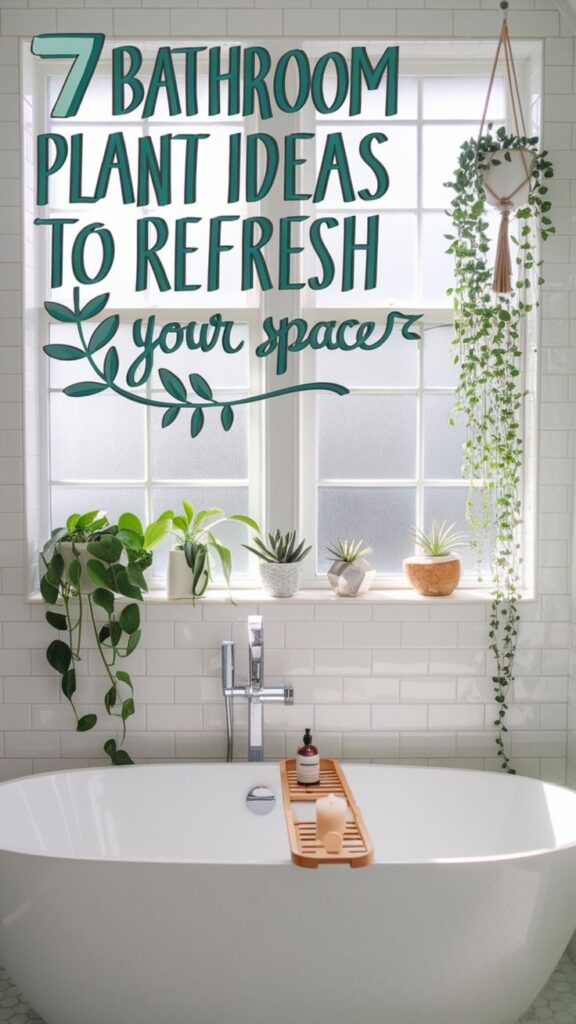
Contents
Lush Boston Ferns: The Classic Bathroom Companion
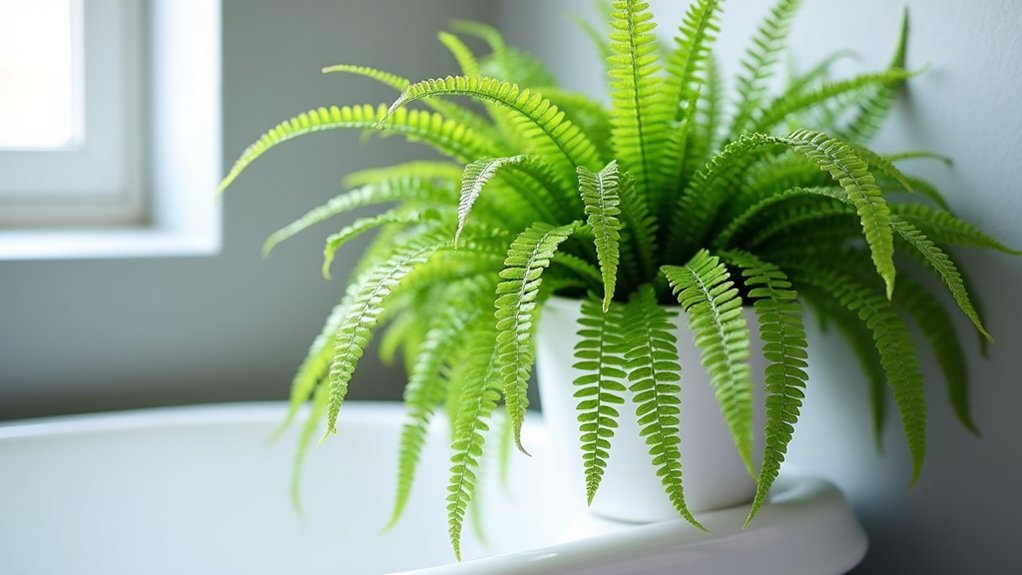
Boston Ferns (Nephrolepis exaltata) are iconic bathroom plants known for their graceful, arching fronds that create a cascading effect of lush green foliage.
These classic houseplants feature delicate, sword-shaped leaves arranged in a symmetrical pattern, growing up to 3 feet in length and forming a full, rounded shape that makes them perfect for hanging baskets or elevated planters in bathroom spaces.
Growing Conditions:
- Light: Bright, indirect light; avoid direct sunlight
- Humidity: High humidity levels (60-80%)
- Temperature: 60-75°F (16-24°C)
- Water: Keep soil consistently moist but not waterlogged
- Soil: Well-draining, organic potting mix
- Fertilizer: Monthly feeding during growing season with balanced liquid fertilizer
Regular grooming is essential for maintaining a healthy Boston Fern.
Remove any yellowed or brown fronds at the base using clean, sharp scissors, and occasionally rotate the plant to ensure even growth.
Mist the plant between waterings to supplement humidity, especially during winter months when indoor air tends to be drier.
If fronds become crowded, divide the plant every few years in spring, which not only maintains its shape but also provides opportunities for propagation.
Peace Lily: A Low-Light Air Purifier
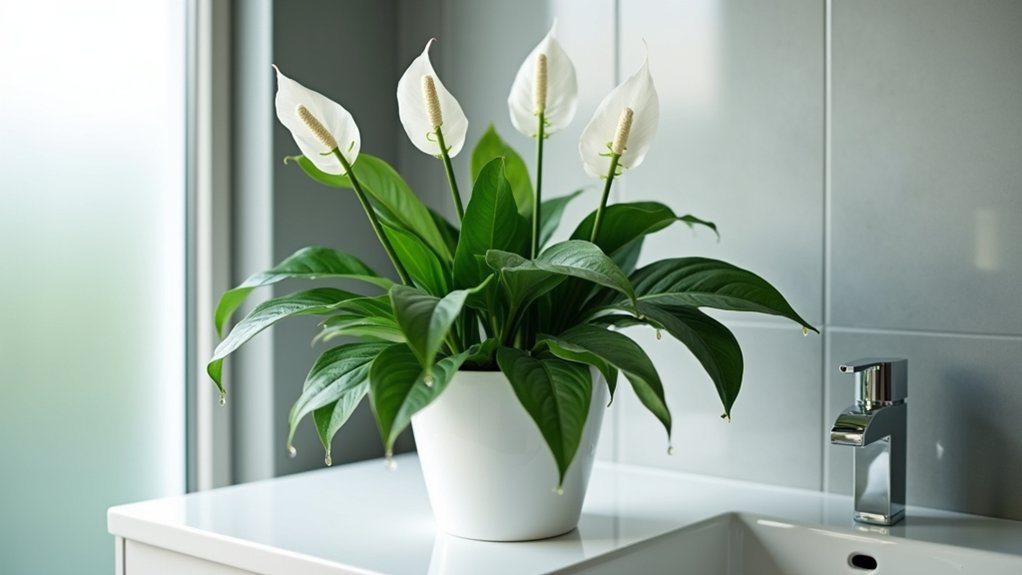
The Peace Lily (Spathiphyllum) is an elegant bathroom plant featuring glossy, dark green leaves and distinctive white flowers that resemble sail-like spathes. This tropical beauty not only adds visual appeal but also serves as a natural air purifier, effectively removing common indoor pollutants like benzene and formaldehyde.
The plant’s compact growth habit and adaptability to humid environments make it particularly well-suited for bathroom spaces.
- Light: Thrives in low to moderate indirect light; avoid direct sunlight
- Water: Keep soil consistently moist but not waterlogged; water when top inch of soil feels dry
- Humidity: Prefers high humidity levels (50-60%)
- Temperature: Maintains best growth between 65-80°F (18-27°C)
- Soil: Well-draining potting mix rich in organic matter
- Container: Pot with drainage holes to prevent root rot
Regular grooming is essential for maintaining a healthy Peace Lily. Remove yellowed or damaged leaves at the base, and trim spent flowers once they begin to fade.
Dust the leaves monthly with a damp cloth to keep them clean and maintain optimal photosynthesis. Repot every 2-3 years when the plant becomes root-bound, and fertilize lightly with a balanced houseplant fertilizer during the growing season, reducing application during winter months.
Snake Plant: The Ultimate Survivor
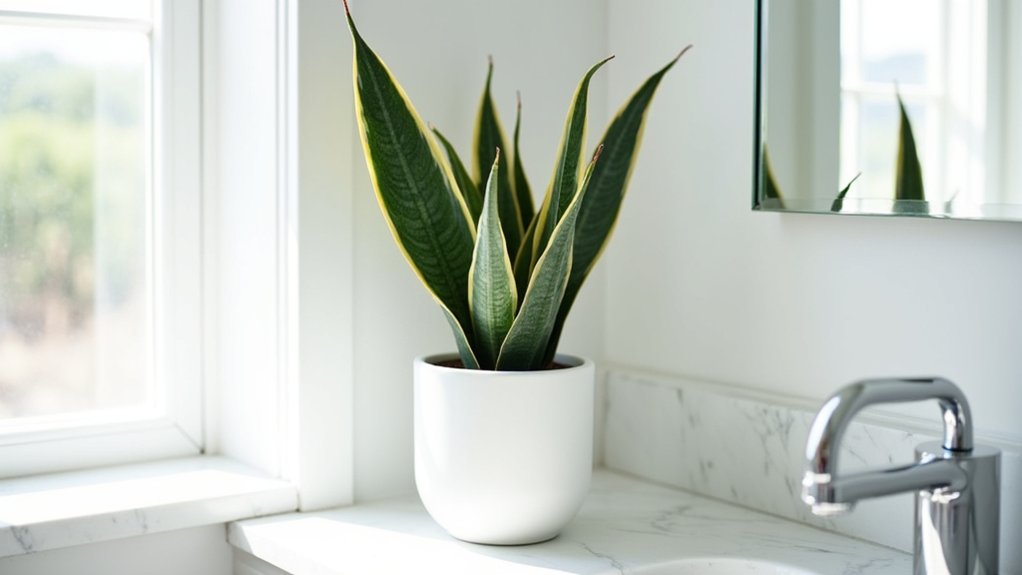
The Snake Plant (Sansevieria trifasciata) stands out as one of the most resilient houseplants available, earning its reputation as the ultimate survivor in indoor environments. Its striking architectural form features tall, rigid leaves that grow upright in a rosette pattern, with varieties showcasing different patterns of green and yellow stripes.
These succulent-like plants can reach heights from 6 inches to several feet, making them versatile choices for both floor plants and bathroom countertops.
- Light: Tolerates low light but thrives in indirect bright light; can handle some direct sun
- Water: Allow soil to dry completely between waterings; water less in winter
- Humidity: Adapts to any humidity level
- Temperature: Comfortable in normal room temperatures (60-85°F)
- Soil: Well-draining potting mix; preferably with sand or perlite added
- Container: Pots with drainage holes to prevent root rot
Maintaining a snake plant primarily involves preventing overwatering, which is the most common cause of problems.
Remove any yellow or brown leaves at the base, and dust the leaves occasionally with a damp cloth to keep them looking fresh and allow for better photosynthesis.
While the plant rarely needs fertilizer, applying a balanced houseplant fertilizer once or twice during the growing season can promote healthy growth.
If the plant becomes too tall or crowded, it can be divided during repotting, which is typically needed every 2-3 years.
Bamboo: Bringing Zen Vibes to Your Bath
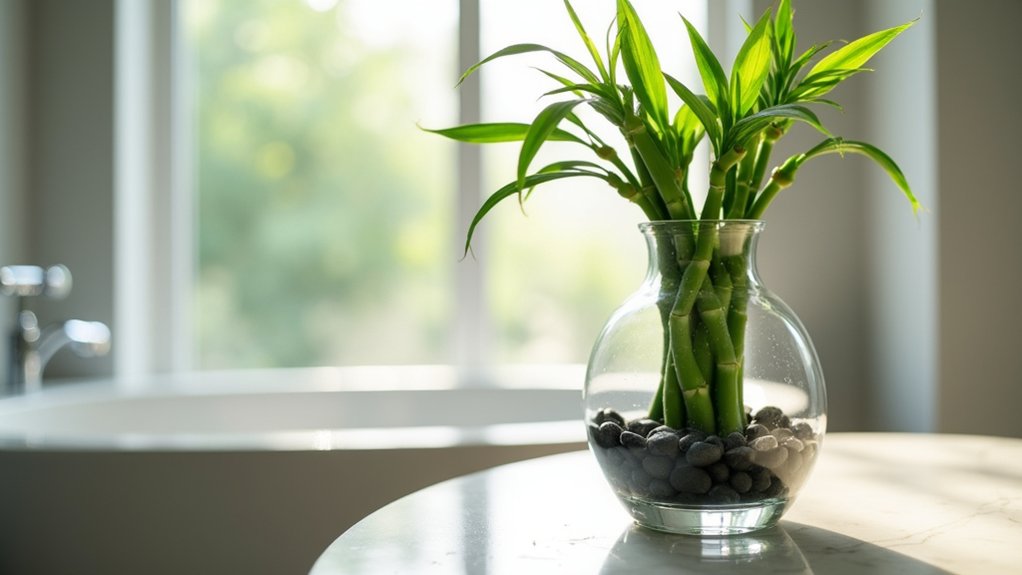
Bamboo brings a serene, Asian-inspired aesthetic to bathroom spaces with its distinctive segmented stems and graceful, lance-shaped leaves.
Lucky bamboo (Dracaena sanderiana), despite its name, isn’t true bamboo but offers the same minimalist appeal and adapts exceptionally well to bathroom environments. Its elegant stalks can be arranged in straight lines or spiral patterns, and the plant can grow either in water or soil, making it a versatile choice for both counter displays and floor arrangements.
- Light: Thrives in moderate to bright indirect light; can tolerate low light conditions
- Water: If grown in water, change water weekly; if in soil, keep consistently moist but not waterlogged
- Humidity: Enjoys high humidity levels, making it perfect for bathrooms
- Temperature: Prefers warm environments between 65-90°F (18-32°C)
- Growing medium: Can grow in either water with pebbles or well-draining potting soil
- Container: Requires containers with drainage holes if planted in soil
Regular grooming helps maintain bamboo’s elegant appearance and promotes healthy growth.
Remove any yellowing leaves promptly, and trim overgrown stalks to maintain desired height. For water-grown specimens, clean the container monthly to prevent algae buildup, and add fresh water when levels drop.
If the stalks begin to yellow, consider adding a few drops of liquid fertilizer every other month during the growing season.
Rotate the container periodically to ensure even growth, as bamboo tends to lean toward light sources.
Spider Plants: Easy-Care Cascading Beauty
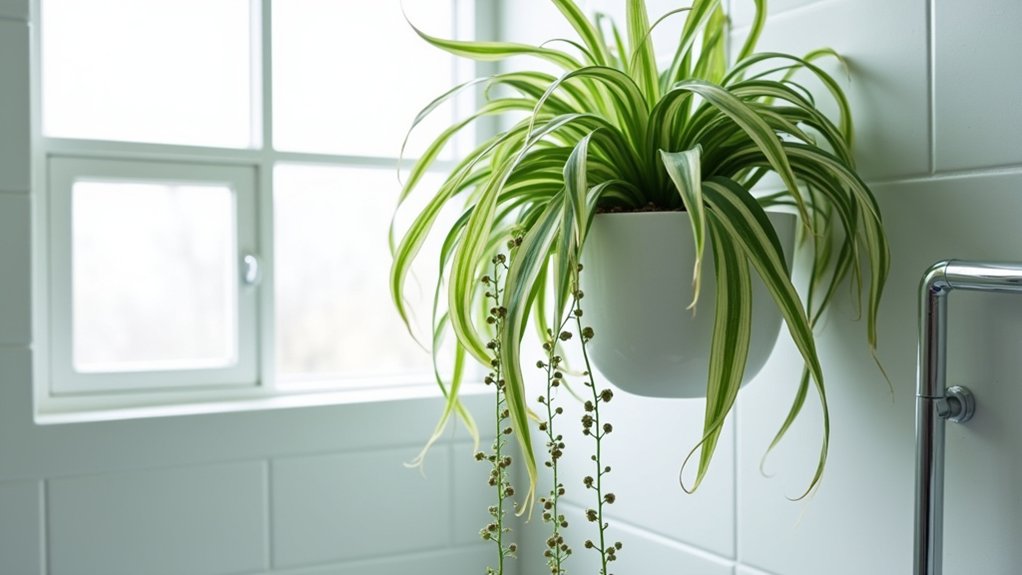
Spider Plants (Chlorophytum comosum) are elegant, arching plants that create a dramatic cascading effect perfect for bathroom settings. Their long, slender leaves feature distinctive green and white variegation, and mature plants produce hanging stems called stolons, which bear baby plants or “spiderettes” at their tips, giving the plant its common name and creating a graceful, multi-tiered appearance.
- Light: Bright to moderate indirect light; can tolerate lower light conditions
- Water: Keep soil consistently moist but not waterlogged; water when top inch of soil feels dry
- Humidity: Thrives in humid environments, making them ideal for bathrooms
- Temperature: Comfortable in normal indoor temperatures between 60-75°F (15-24°C)
- Soil: Well-draining potting mix with good aeration
- Container: Hanging baskets or elevated pots with drainage holes
To maintain a healthy Spider Plant, remove any yellowed or brown leaves at the base of the plant, and trim off dried stolons as needed. The plant can be refreshed by occasional pruning of older leaves to encourage new growth.
Spider Plants can become rootbound over time, so repot every 2-3 years or when roots start emerging from drainage holes. Propagation is simple by separating and potting up the baby plantlets once they develop their own roots while still attached to the mother plant.
Orchids: Elegant Tropical Luxury
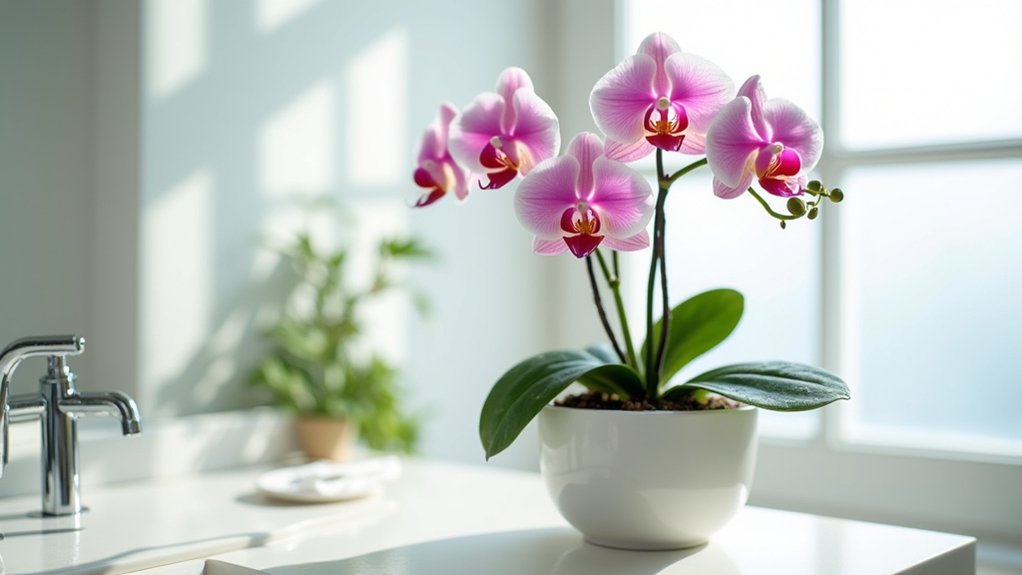
Orchids bring an unmatched sophistication to bathroom spaces with their delicate, exotic blooms and arching stems. These tropical beauties come in countless varieties, featuring dramatic flowers in whites, pinks, purples, and striking patterns that can last for months.
Their thick, waxy leaves and aerial roots create visual interest even when not in bloom, while their compact size makes them perfect for countertops, windowsills, or hanging displays.
- Light: Bright, indirect light; avoid direct sunlight which can burn leaves
- Humidity: 50-70% humidity level
- Temperature: 65-80°F (18-27°C)
- Water: Weekly during growing season; allow top inch of medium to dry between waterings
- Growing Medium: Specialized orchid mix with bark, charcoal, and perlite
- Container: Well-draining pot with plenty of ventilation holes
- Fertilizer: Balanced orchid fertilizer at quarter strength every other watering
To maintain healthy orchids, remove spent blooms with sterile scissors and watch for signs of root rot, which can develop if the plant stays too wet.
Regular inspection of roots through clear plastic pots helps monitor plant health. After blooming, reduce watering slightly but maintain humidity.
Repot every 1-2 years when the growing medium breaks down, and clean leaves occasionally with a damp cloth to remove dust and allow better light absorption.
Consider grouping multiple orchids together to create humidity pockets and enhance their decorative impact.
Air Plants: No-Soil Solutions for Small Spaces
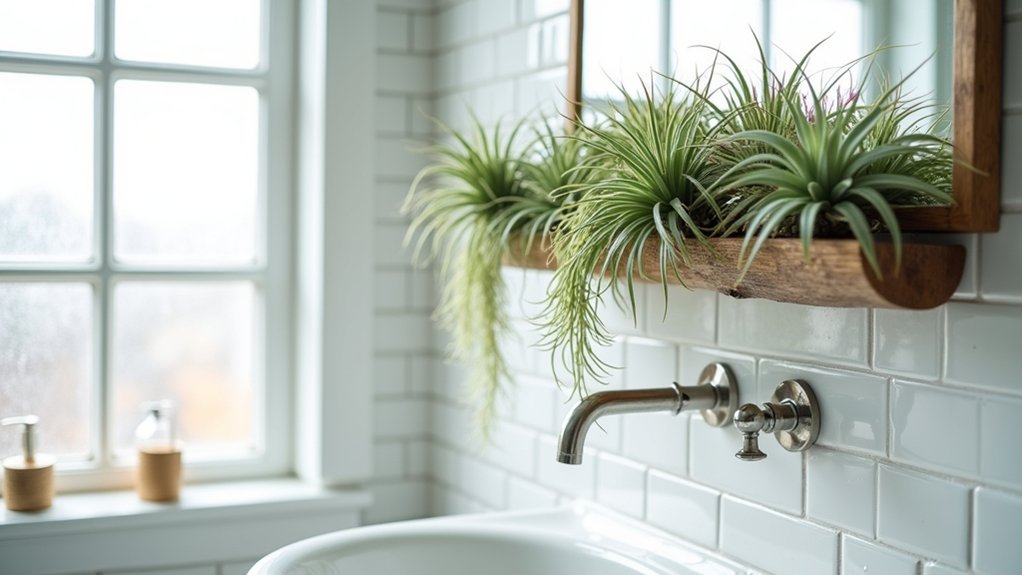
Air plants (Tillandsia) are unique, soil-free plants that naturally grow attached to other plants or surfaces in tropical environments. These fascinating specimens come in various shapes and sizes, from small silvery-green rosettes to larger, trailing forms with spiky leaves. Their ability to absorb nutrients and moisture through specialized scales on their leaves, called trichomes, makes them perfect for bathroom environments where they can thrive without the need for traditional potting methods.
- Light: Bright, indirect light; avoid direct sunlight which can burn leaves
- Humidity: High humidity (50-70%); bathroom steam provides ideal conditions
- Temperature: Prefer 50-90°F (10-32°C)
- Water: Mist 2-3 times per week or soak in room temperature water for 20-30 minutes weekly
- Mounting: Can be displayed in glass terrariums, mounted on driftwood, or placed in decorative holders
- Ventilation: Good air circulation to prevent rot
To maintain air plants in peak condition, rotate them periodically to ensure even growth and prevent one-sided development. Remove any dead or browning leaves by gently pulling them away from the base.
After watering, shake off excess moisture and place the plant upside down on a towel to drain completely, preventing water from collecting in the crown which can lead to rot. Fertilize monthly during growing season with a bromeliad-specific fertilizer at quarter strength to promote healthy growth and potential blooming.
